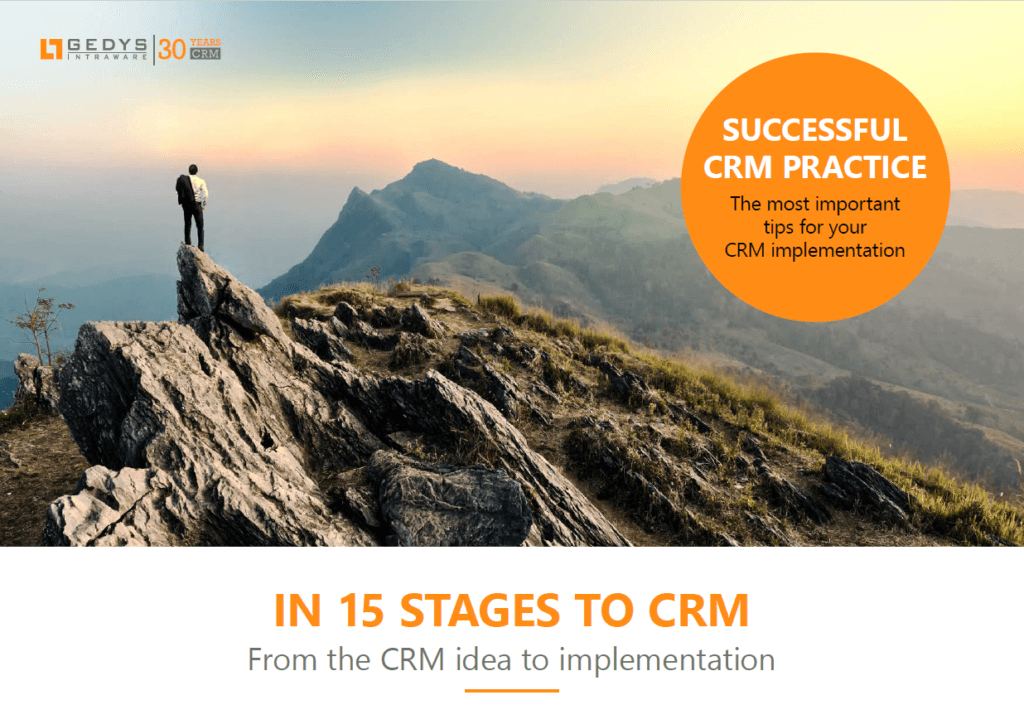INTRODUCTION OF A CRM SYSTEM
The ultimate guide for implementation of a CRM system!
Is the introduction of a CRM system your next goal? Once you have realized that your company needs a CRM system, there are a few things to consider when introducing it.
First, you should be aware of what you want to achieve by implementing a CRM system, what prerequisites you need to create for it, and what system you want it to be. Once all this has been clarified, create a schedule for the phases of the “CRM system implementation” project. In the following you will find a lot of help with these stages.

Table of Contents
Introduction of a CRM system: The goal
In conjunction with your individual CRM strategy, a CRM system aims at the systematic optimization of your customer loyalty and new customer acquisition.
The specific objective that this explicitly means for your company depends on you. There are various core fields, but all of them are initially based on the targeted collection, management and use of data. These are then used in turn to optimize customer support and satisfaction.
This is done, for example, in the form of software-based process optimization or data evaluation with the findings of which customer-oriented decisions are made in relation to workflow, service, product, etc. After all, the CRM system will not only benefit satisfied customers, but also your relieved employees.
For more details, read our blog article 4 Advantages of CRM.

Prerequisites for successful CRM implementations
Before planning the concrete steps for the introduction of a CRM system, it proves advantageous to ensure certain prerequisites. These can be classified on different levels.
Strategic level
At the strategic level, if you do not already have, you should incorporate a specific CRM strategy into your corporate strategy. This means wondering what goals are being set in terms of dealing with customers and developing them. These can be, for example, sales targets or planned expansions of certain customer segments. It is a good place to define specific quantities for measuring success here.
If necessary, a new orientation of the strategy may then also be accompanied by more fundamental adjustments.
Organization level
A very basic prerequisite for CRM implementation is also the evaluation and possible adaptation of your company organization. This includes evaluating existing business processes and determining which processes may require alignment or optimization. You should define workflows and all contact points along the Customer Journey to optimally fit the CRM system into your business model.
Part of the structural prerequisites for implementation is also the definition of a CRM manager as project manager and a CRM team from the key users of the various departments, such as sales, service, marketing. This serves to ensure a structured project process as well as to integrate possibly different requirements of different business areas.
Employee level
The latter point is also directly linked to the necessary on-boarding of the employees. If possible, involve all employees through the CRM team’s path to the development of CRM system requirements. In this way, later friction points can be anticipated in a first step.
Also convey the benefits that a CRM system can bring, making it clear that these benefits depend to a particular extent on whether everyone involved later works extensively with the CRM software. See also the Youtbe video on the functional overview. Empowering and motivating employees is a fundamental requirement for a successful CRM implementation.
Cultural level
Strive for a clear alignment of your corporate culture towards the customer and his needs. If customer orientation is firmly anchored in the company, it is easier for all parties involved to think and react in the appropriate way. In addition, a clear line also supports the motivation of the employees.
A CRM sponsor, for example, is also decisive. This person is optimally part of the management, convinces of the CRM project and actively drives the implementation of the CRM strategy and system. This makes it a prerequisite for the company-wide acceptance of CRM system implementation.
Choosing the right CRM system
If the above requirements are met, make the choice of a suitable CRM system. When researching and sorting the various CRM software providers, you can orientate yourself on a few criteria, about which we will give you a brief overview.

First selection:
Create long list
- Your size or scalability of the software
- Your number of users
- Your IT infrastructure
- System requirements of the software
- The provider’s industry knowledge
- Your developed “must-haves” of features
Also, discover nine questions you should ask yourself about CRM comparison in our blog article. Use our CRM requirements overview checklist to quickly and easily compare your vendor choices.

Containment:
Create short list
In the meantime, you have created a specification in the CRM team that contains your requirements for the CRM system. You now send this to the software providers of the long list for request. You will then receive an offer and the completed specifications back.
By comparing the providers in detail, you limit your selection to a short list of about four CRM systems.

Narrower selection:
Create short list
The vendors on your short list now invite you to personal presentation dates, during which the CRM software is presented in detail. In addition to the concretely presented functions and the experience of the user interface, the chemistry between you and the software provider counts here.
When choosing a CRM system, you should pay attention to a good relationship of trust with the software manufacturer. It is only from the moment of selection that the exciting part of the CRM implementation begins.
You can find more information about the selection on our wiki page CRM selection with system.
A successful project plan
1. The most important phases and milestones of a CRM implementation
From the start of the CRM project to the Go-Live of the new CRM system, as you will have noticed, there are a few steps to be taken. Following the most important phases and milestones, we have regrouped the most important phases and milestones in a model way for you, so that you can easily get an idea of a successful project plan.
2. Project plan CRM implementation – a phase model
00
The starting signal
The management level decides to introduce CRM. There is usually a CRM sponsor who is particularly active in promoting, representing & disseminating the project.
Starting shot:
Internal announcement
01
Phase 1:
CRM strategy
The management level develops a CRM strategy that is implemented in the company’s strategy. This includes objectives and values related to the company’s customer relationships.
Milestone 1:
CRM Strategy Paper
02
Phase 2:
Organization
A CRM manager is used to advance the strategic and technical integration of CRM in the company. This can come from an internal position or can be set from external.
Milestone 2:
CRM Manager
03
Phase 3:
Find key users
The CRM manager needs support from the different departments of the company for the following phases of the CRM implementation project plan. There he is looking for various key users who work out the requirements for the software together with him as a CRM team.
Milestone 3:
CRM team
04
Phase 4:
Actual & target analysis of the departments
In order to define the requirements for a CRM system, the first step is to determine the existing processes and circumstances of the various departments. The CRM team supports the CRM manager. The collected prerequisites and requirements for the CRM system result in the specifications.
Milestone 4:
Specifications
05
Phase 5:
Selection process
With the help of the specifications, suitable CRM systems are now searched for in several steps from a long list to a short list. Live presentations and CRM consulting by the vendors help to finally filter out the software that fits best from the shortlist.
Milestone 5:
CRM system selected
06
Phase 6:
CRM Workshop
Once a suitable CRM system has been found, a workshop with the provider discusses the requirements in detail and determines the further project plan. A timetable for the introduction and concrete presentation of individual adaptations and integrations is written down.
Milestone 6:
Specification
07
Phase 7:
Customizing
The CRM software provider is now beginning to conceptualize and implement the individual customizations. Rolling pilot tests are carried out by the key users of the CRM team, who already receive training for the new system for this purpose.
Milestone 7a
If a pilot passes testing by meeting all requirements, this phase is considered complete.
Milestone 7b:
Preliminary Acceptance
08
Phase 8:
Employee training & roll-out
From now on, employees will receive training to work comprehensively with the new CRM system. Well trained, employees are postitively motivated to use the new software extensively. The roll-out is taking place in parallel.
Milestone 8
Employee motivation, end of go-live preparation.
09
Phase 9:
Go-Live
Once all the preparatory steps have been completed, the CRM system goes live and the implementation is complete.
Milestone 9
Target summit reached, final acceptance of the CRM system
10
Phase 10:
Continuous maintenance of the CRM system
It is recommended that regular CRM audits be held after the Go-Live, in which any difficulties or new ideas are discussed and included. It is practical to have a CRM expert from the provider’s company directly present in order to immediately evaluate feasibility and contribute experience.
Milestone 10
Living CRM
3. CRM introduction becomes a CRM project
In fact, phases 7 to 9 are usually done in a more small-step process than our model above. According to the motto, it is more evolutionary than revolutionary, for example, it is a good thing to introduce the CRM system for department by department. In this case, of course, your concrete project plan would be much more complex. In addition, it should be part of every CRM project plan not to end the project with the final acceptance of the CRM system: A CRM lives and wants to be maintained sustainably!
Here you can learn more about the Phases of the introduction of a CRM system.
Conclusion: CRM implementation is easier with motivation
The successful introduction of a CRM system depends, on the one hand, on clearly defined goals and goal-oriented project planning and, on the other hand, heavily on the motivation and participation of employees. Because the best CRM system is for the cat when it is not used.
Free e-book In 15 steps to CRM

From the CRM idea to implementation: The 15 most important steps for CRM introduction briefly and clearly summarized

